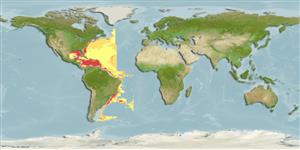>
Trachichthyiformes (Roughies) >
Trachichthyidae (Slimeheads)
Etymology: Hoplostethus: Greek, hoplon = weapon + Greek, stetho, stethion = brest; literal = to prick a little breast (Ref. 45335).
Environment: milieu / climate zone / depth range / distribution range
Écologie
marin bathypélagique; profondeur 485 - 550 m (Ref. 9869). Deep-water
Atlantic Ocean: southern Nova Scotia south to the northern part of the Gulf of Mexico, on the eastern seaboard of Florida, in the Bahama, in the west and southern Caribbean, and around Venezuela, Guyana, Suriname, Tobago and Brazil.
Taille / Poids / Âge
Maturity: Lm ? range ? - ? cm
Max length : 17.3 cm SL mâle / non sexé; (Ref. 37108)
Épines dorsales (Total) : 6; Rayons mous dorsaux (Total) : 13; Épines anales: 3; Rayons mous anaux: 9. Pectoral fin long, its tip extending beyond anal fin origin (Ref. 13608). Scales adherent, spinules small, margins serrate, spines on fin rays small. Denticles on head bones small, septae relatively strong (Ref. 37108).
Life cycle and mating behavior
Maturité | Reproduction | Frai | Œufs | Fécondité | Larves
Kotlyar, A.N., 1986. Systematics and distribution of species of the genus Hoplostethus Cuvier (Beryciformes, Trachichthyidae). Trudy Inst. Okeanol. 121:97-140. (Ref. 9869)
Statut dans la liste rouge de l'IUCN (Ref. 130435: Version 2024-2)
Menace pour l'homme
Harmless
Utilisations par l'homme
Pêcheries: sans intérêt
Outils
Articles particuliers
Télécharger en XML
Sources Internet
Estimates based on models
Preferred temperature (Ref.
123201): 8.3 - 13.5, mean 9.4 °C (based on 21 cells).
Phylogenetic diversity index (Ref.
82804): PD
50 = 0.5000 [Uniqueness, from 0.5 = low to 2.0 = high].
Bayesian length-weight: a=0.01660 (0.00714 - 0.03859), b=3.05 (2.85 - 3.25), in cm total length, based on LWR estimates for this (Sub)family-body shape (Ref.
93245).
Niveau trophique (Ref.
69278): 3.6 ±0.59 se; based on food items.
Résilience (Ref.
120179): Très faible, temps minimum de doublement de population supérieur à 14 ans (Preliminary K or Fecundity.).
Fishing Vulnerability (Ref.
59153): Low vulnerability (11 of 100).
